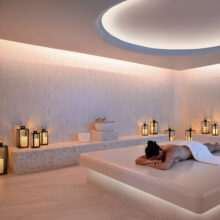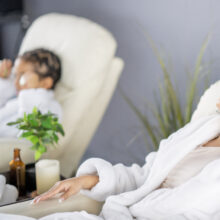Knead to Relax? The Physical and Emotional Benefits of Massage
- Published: Sunday, February 7th 2016
- in Living Well
When most of us think of spa days we almost immediately conjure up the image of lying on a warm table, as soft music and gentle aromas fill the air and an extremely talented therapist relaxes us with a firm and well-executed massage. When we actually experience this spa go-to, whether enjoying 10 minutes, 30 minutes or a full-body two-hour massage, we usually find ourselves leaving feeling like an entirely new person. Ever wonder why just one session of massage therapy has the capability to leave us feeling brand new? Thanks to the powers of the human touch, the benefits of massage are innumerable.
The Chinese have used massage since 1600 BC, and the technique has been mentioned in ancient records from the Arabic, Egyptian, Greek, Japanese, Greek and Roman nations as well. One of the most recent of several studies published on the actual benefits of massage therapy was printed in the Science Translational Medicine journal, which found that short 10-minute sports massage can reduce inflammation after working out. As we’ve written before, the benefits of sports massage, which is a variation and combination of the more common Swedish and deep tissue massage modalities, are improved fitness endurance and performance, increased flexibility and recovery time and injury prevention. However, sports massage isn’t the only modality that reaps benefits post massage.
According to The Mayo Clinic, the benefits of massage include:
• Stress Relief
• Managing Anxiety and Depression
• Alleviating Pain and Stiffness
• Controlling Blood Pressure
• Infant Growth
• Sports-Related Injuries
• Boosting Immunity
• Cancer Treatment
There are as many as 80 different massage modalities and techniques, and the most common link between all of them is the human touch. Throughout the years research has shown the profound benefits from something as simple as this platonic skin-to-skin interaction. We crave being touched as newborns; in fact, premature infants are known to thrive from this simple gesture. My favorite story is of Brielle and Kyrie Jackson, twins born 12 weeks before their due date in Worcester, Massachusetts, and immediately placed in separate incubators. Brielle, weighing only two pounds, was struggling with breathing and had heart rate difficulties, while Kylie, two pounds, three ounces, was considered the stronger of the two. After less than a month Brielle became increasingly stressed, and the nurse thought to co-bed the infants. Brielle instantly calmed down upon the twins being placed together in one incubator. Her breathing was regulated to that of her sister’s , her blood-oxygen levels improved, and it seemed that the power of Kylie’s “Rescuing Hug” as it was dubbed, had been enough to save Brielle.
Thanks to the massive benefits of massage, it is now becoming commonplace for doctors to write prescriptions for monthly massage for their patients in order to alleviate back pain and help with anxiety. This is all yet another example of the Spa Evidence trend that was highlighted back in 2012 as part of Spafinder Wellness 365’s 2012 Global Spa & Wellness Trends Report. “More hospitals than ever before will incorporate – and more doctors will prescribe – spa and wellness approaches, not only because more new research shows that mind-body treatments can be especially effective for chronic pain, heart disease, sleep disorders and depression/anxiety, etc., but because the sheer global costs of not focusing on prevention have passed the tipping point.”
From deep tissue massage to Thai massage, the emotional and physical benefits of massage have the ability to pay us back tenfold.



